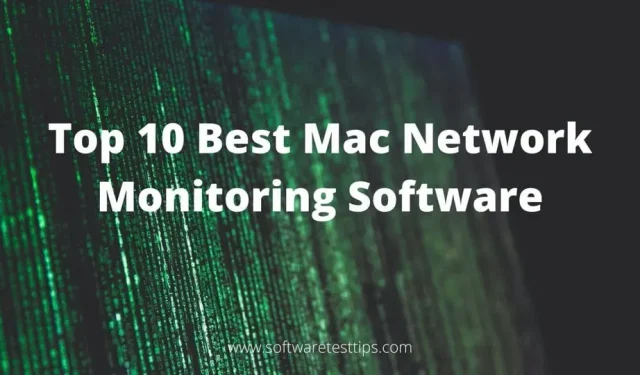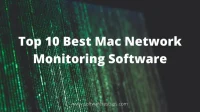There are many reasons why design agencies, educational institutions, doctors’ offices, marketing firms, and various other organizations prefer Mac OS X to Windows and Linux.
The main reasons are the reliability and security features provided by Mac OS. This OS also requires less overhead and maintenance.
However, getting the right network monitoring software for the Mac OS X platform is not easy because many commercial and free open source network monitoring software is not made for this platform.
The Mac offers many built-in network management software for monitoring purposes, but many organizations are looking for software that provides more options and better support.
How to monitor network traffic on Mac?
Apart from the list of top 10 Mac network monitoring software below, there is a way to use Activity Monitor window to monitor traffic on Mac without any software.
The Activity Monitor application built into Mac OS allows you to monitor traffic. In this application, click on the network or use the touchpad for the same.
A window will open with the following options:
- Packets per second, outbound packets/sec: This is the rate at which data packets are transmitted per second in or out of the network. It can be displayed as a graph.
- Data Received/sec, Data Sent/sec: Shows the amount of information in bytes moved per second. It is also called throughput and can be shown on a graph.
- Packets In, Packets Out: Displays the total number of packets sent and received over the network.
- Data Received, Data Sent: This is the amount of information moved over the network in megabytes.
However, as discussed earlier, this tool does not provide additional features or support, so it may not be suitable for organizational purposes.
Why should I use network monitoring software on Mac?
There are many functions running on your Mac, some of which are innocent and necessary; however, others may be responsible for slowing down and reducing the security of your Mac.
This non-essential software may contain malware that spy on your network and monitor data sent and received through other apps, entertainment apps and even cloud interactions.
Monitoring tools can intercept and block these malware, thus protecting your system. The built-in firewall in Mac OS is disabled by default and can only protect users from incoming connections, but does not control outgoing calls and requests.
The monitoring software can also monitor network and hardware tasks on a Mac, which is a bonus.
How can I see all devices connected to my Mac network?
Monitoring tools provide you with a great way to easily monitor all connected devices on your network.
This feature is also built into the Mac with the “Ping”command, which can be accessed through the command line or the network utility.
Go to “Terminal”inside “Applications”-> “Utilities”or type terminal after pressing Ctrl + Space. Here, type “ping”and your IP address with subnet mask and press Enter.
Your IP address and subnet mask can be found on the TCP/IP tab under Network in System Preferences.
For example, let’s say your IP address is 182.168.1.100 with a subnet mask of 255.255.255.0, then your ping command would be ping 182.168.1.255. This will show all devices connected to your local network. But not all devices will respond to pings depending on their port.
How to Track Internet Downtime on Mac?
Network monitoring tools available in the market for Mac OS can help you monitor internet outages using IP addresses.
These programs use HTTP, TCP/IP, and SSH to monitor devices on the network such as servers, switches, routers, and so on.
Even non-standard devices such as cameras, heart monitors, production equipment and software applications can also be monitored using network monitors.
10 Best Network Monitoring Software for Mac
1. Radio silence
Website: Radio Silence
Radio Silence, developed by the same developer behind Mac Private Eye, can replace private Eye and give you the functionality to monitor network activity and block unwanted connections.
It is a simple and effective tool that provides a transparent interface to view all the processes running on your Mac, as well as the total number and specific methods in each application.
It uses helpers, in-memory processes, XPC services, executables, daemons, etc. to perform monitoring. It comes with a firewall to block or accept incoming and outgoing connections from the application.
This network monitor runs on OS X 10.6 Snow Leopard and up, including Sierra and El Capitan. If you are using versions earlier than OS X 10.10 Yosemite, you will need to download older versions of the software.
2. Little Snitch
Website: Little Snitch
Little Snitch, developed by German developers, is a commercial, user-friendly and user-friendly network monitoring software that can protect your network with its firewall.
Little Snitch sometimes picks up on Mac OS X cryptic calls and asks if you’ll deny or allow them.
In older versions, you had to look for these callouts and then make a decision; however, its latest version is equipped with a research assistant that does this search for you and tells you what the process is doing and whether it is safe or not.
For each application and process, you can allow or deny the connection. The tool will remember your choice, thus reducing your anxiety about this challenge.
The software can feel a bit tedious on the first try as there are a lot of apps and utilities that ask for everything you will have to accept or decline.
After you make these settings, the software will remember your choice and won’t bother you about it again.
Little Snitch is available for free, but its latest version is only compatible with Sierra. If you have El Capitan, Mavericks, or Yosemite, you will need to download their legacy versions.
3. Menu meters
Website: MenuMeters
This network monitoring tool is a free and open source monitoring software that can monitor network activity, CPU, memory and disk on your Mac.
This is the basic version of the iStat menu with a similar look, functionality and features. This open source tool can be used with older versions of Mac OS X.
The developers of the tool have stated that MenuMeters is not compatible with OS X 10.11 El Capitan or later because changes in the macOS architecture impose code signing restrictions such as SIP security measures. However, tests have confirmed that it works with 10.12 Sierra or higher.
4. SME SolarWinds
Website: SolarWinds MSP
SolarWinds is a great network monitoring tool for Mac and PC as it provides a reliable RMM for medium to large businesses.
The SolarWinds MSP tool, formerly known as LOGICnow, provides full control over network monitoring for mobile devices, Macs and PCs.
It also offers backup and recovery, password management, mail protection and archiving, and threat monitoring services.
It’s easy to set up. You also get features like deep replication, WAN optimization, and change data capture that provide secure data backups that iCloud doesn’t.
5. Website24×7
Website: Site24x7
Site24x7, owned by Zoho, offers users a 30-day free trial of the software, after which the price starts at $9 per month, including one extended monitor and ten basic monitors.
Site24x7 allows users to perform infrastructure monitoring and application performance monitoring for thousands of Macs, PCs and websites simultaneously in real time.
This helps the DevOps team troubleshoot applications and servers and effectively monitor the network infrastructure.
Its performance and monitoring capabilities are impressive as it allows you to support applications, servers, real-time users, cloud applications, networks, etc.
The tool might not be the best choice for beginners and will prove overwhelming without system administration experience.
6. Activity monitor
Website: Activity Monitor
Activity Monitor is a tool built into MacOS that is very effective for network monitoring due to its simplicity and monitoring capabilities. It can manage network activity, resource status, application performance, and more.
To access it, you need to find Mac Activity Monitor spotlight and you can view all currently running processes. The network tab displays data packets sent and received by applications.
You can exit any of these processes, but be sure to find them first as they may be needed, such as “netbiosd”or “apdsd”.
7. Terminal
If you don’t want to use any tool and are comfortable using the Mac terminal, you can use the “tcpdump”command to monitor network traffic.
To do this, you need to be logged in as an administrator and you need to know how to read the trace packet.
This option is crude and requires technical know-how to monitor your networks. So, for the average user with little knowledge of the terminal and packages, you will be better off using an application that provides all the features you need.
8. Jamph
Website: Jamf
Specialized in Apple devices, Jamf is the best monitoring tool for Mac users and is used by 8 out of 10 Fortune 500 companies as their network management software.
The software is easy to deploy, inventory, connect and manage networks large and small on Macs and other Apple devices such as iPhones and iPads.
Depending on the size and needs of the organization, the tool offers its services at three levels:
- Jamf Now: It’s best suited for businesses with no system administration experience and in need of a simplified network management software for Mac.
- Jamf School: Designed specifically to meet the needs of schools and other educational institutions with networks running on Macs and other Apple devices.
- Jamf Pro: It is best suited for IT professionals who are working on advanced management and enterprise-grade features and functionality.
It can manage up to 3 devices for free, after which the cost is $2 per device. You can try it for free before you decide to buy it.
9. iStat menu
Website: iStat Menu
Like Little Snitch, iStat Menus is an easy-to-use and powerful network monitoring software for Mac that focuses on hardware performance.
With Little Snitch, you can get a 14-day free trial of the software, after which prices start at $18 for a single license and $25 for a family license. It can be upgraded for $9.99 and $14.99.
It can monitor incoming and outgoing internet connections, ports, and other hardware tasks such as resource allocation, CPU usage, RAM usage, etc.
It summarizes CPU resource logs, detailed battery health analysis, network monitoring information, and more.
This tool is a good choice for those who only want to track traffic data but don’t want to perform other aggressive functions like blocking or app control.
10. Rush hour 4
Website: Rush Hour 4
PeakHour is a discreet network monitoring and diagnostic tool that allows Mac users to monitor performance, Internet connection performance, and other network diagnostics.
It comes with a 10 day free trial after which you have to pay $9.99 for the full app which will allow you to monitor and perform full network diagnostics on various apps like video streaming apps like YouTube, Amazon Video, iTunes, Netflix., etc.
It’s easy to set up and allows you to discover your router, measure your internet speed, and remotely monitor your iPad and iPhone.
The monitoring tool doesn’t offer advanced network monitoring or analysis, but it’s great for troubleshooting application performance and internet connectivity.


